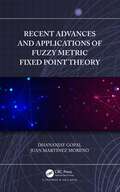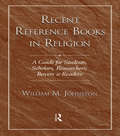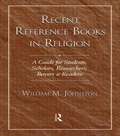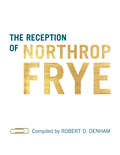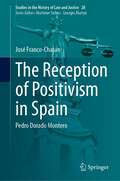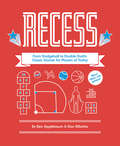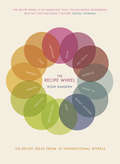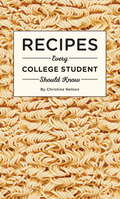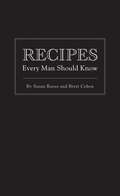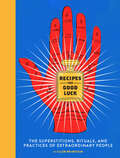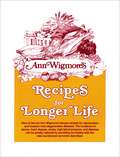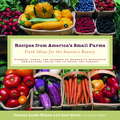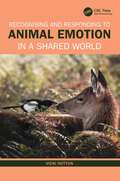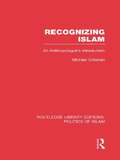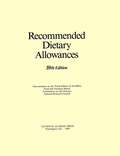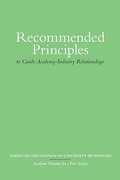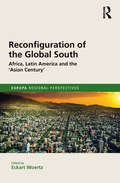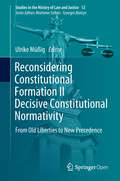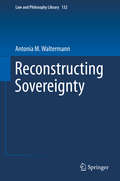- Table View
- List View
The REBT Therapist's Pocket Companion
by Windy Dryden Michael NeenanThe REBT Therapist's Pocket Companion presents in this format to encourage busy trained and developing REBT clinicians to think about the practice of REBT and what two established REBT therapists regard as important principles of its professional practice.
Recent Advances and Applications of Fuzzy Metric Fixed Point Theory
by Dhananjay Gopal Juan Martinez MorenoThis book not only presents essential material to understand fuzzy metric fixed point theory, but also enables the readers to appreciate the recent advancements made in this direction. It contains seven chapters on different topics in fuzzy metric fixed point theory. These chapters cover a good range of interesting topics such as con- vergence problems in fuzzy metrics, fixed figure problems, and applications of fuzzy metrics. The main focus is to unpack a number of diverse aspects of fuzzy metric fixed point theory and its applications in an understandable way so that it could help and motivate young graduates to explore new avenues of research to extend this flourishing area in different directions. The discussion on fixed figure problems and fuzzy contractive fixed point theorems and their different generalizations invites active researchers in this field to develop a new branch of fixed point theory. Features: Explore the latest research and developments in fuzzy metric fixed point theory. Describes applications of fuzzy metrics to colour image processing. Covers new topics on fuzzy fixed figure problems. Filled with examples and open problems. This book serves as a reference book for scientific investigators who want to analyze a simple and direct presentation of the fundamentals of the theory of fuzzy metric fixed point and its applications. It may also be used as a textbook for postgraduate and research students who try to derive future research scope in this area.
Recent Reference Books in Religion: A Guide for Students, Scholars, Researchers, Buyers, & Readers
by William M. JohnstonRecent Reference Books in Religion provides incisive summaries and evaluations of more than 350 contemporary reference works on religious traditions ancient and modern that have been published in English, French and German. For maximum usefulness to readers, Professor Johnston has broadly defined religion to include not just the world religion of Christianity , Judaism, Islam, Hinduism, and Buddhism but also such alternative approaches as mythology, folklore, and the philosophy of ethics. Each entry, analyzing a particular work, includes full bibliographic details as well as commentary: outstanding articles and contributors are highlighted, strengths and weaknesses are carefully noted and weighed. Readers are directed to volumes whose strengths and weaknesses are carefully noted and weighed. Readers are directed to volumes whose strengths complement the weaknesses of others. An indispensable guide in any religious studies collection, Recent Reference Books in Religion: 2nd Edition includes works published through the end of 1997. It also includes a Glossary that describes types and functions of refernce books, and five indexes: Titles, Authors, Topics, Persons and Places.
Recent Reference Books in Religion (2nd edition)
by William M. JohnstonRecent Reference Books in Religion provides incisive summaries and evaluations of more than 350 contemporary reference works on religious traditions ancient and modern that have been published in English, French and German. For maximum usefulness to readers, Professor Johnston has broadly defined religion to include not just the world religion of Christianity, Judaism, Islam, Hinduism, and Buddhism but also such alternative approaches as mythology, folklore, and the philosophy of ethics. Each entry, analyzing a particular work, includes full bibliographic details as well as commentary: outstanding articles and contributors are highlighted, strengths and weaknesses are carefully noted and weighed. Readers are directed to volumes whose strengths and weaknesses are carefully noted and weighed. Readers are directed to volumes whose strengths complement the weaknesses of others. An indispensable guide in any religious studies collection,Recent Reference Books in Religion: 2nd Edition includes works published through the end of 1997. It also includes a Glossary that describes types and functions of reference books, and five indexes: Titles, Authors, Topics, Persons and Places.
The Reception of Northrop Frye
by Robert DenhamThe widespread opinion is that Northrop Frye’s influence reached its zenith in the 1960s and 1970s, after which point he became obsolete, his work buried in obscurity. This almost universal opinion is summed up in Terry Eagleton’s 1983 rhetorical question, "Who now reads Frye?" In The Reception of Northrop Frye, Robert D. Denham catalogues what has been written about Frye – books, articles, translations, dissertations and theses, and reviews – in order to demonstrate that the attention Frye’s work has received from the beginning has progressed at a geomantic rate. Denham also explores what we can discover once we have a fairly complete record of Frye’s reception in front of us – such as Hayden White’s theory of emplotments applied to historical writing and Byron Almén’s theory of musical narrative. The sheer quantity of what has been written about Frye reveals that the only valid response to Eagleton’s rhetorical question is "a very large and growing number," the growth being not incremental but exponential.
The Reception of Positivism in Spain: Pedro Dorado Montero (Studies in the History of Law and Justice #28)
by José Franco-ChasánPedro Dorado Montero was one of Spain’s most relevant authors. He contributed to modern Criminal law and Penology with a very unique theory: the Protective Law for Criminals. In a time when neoclassical penal theories and new positivist theories clashed, Dorado Montero’s proposal served as a bridge between the criminal law conceptions of the 19th and 20th centuries.In order to explore his role in the introduction of positivism within Spain and the subsequent success of this trend, this book addresses several aspects. The first three analyzed are his scholarly career, the historical and international context in which he lived, and the various European and other international influences he was exposed to. On this basis, two major points are then discussed.Firstly, Dorado Montero has been traditionally included within the movement known as correccionalismo. However, his legal-philosophical and criminal thought indicates otherwise. It seems to lie closer to positivism than to neoclassical positions. This research aims at challenging the accuracy of the ‘eclectic’ label which traditional historiography has applied to him.In turn, Dorado Montero described a reality in which every moral value and legal representation was a mere product of mankind’s imagination. Man is responsible for the elaboration of morals, law and culture in his own mind. Thus, for him, there were as many moral and legal orders as there were human beings on the planet. Such a claim is polemic even today. Unsurprisingly, the author received criticism from both neoclassical and positivist schools. Thus, the existence of a ‘Doradian positivism’ is explored. Despite the growing interest in these topics over the last few decades, Dorado Montero has somehow been overlooked – even though his Derecho protector de los criminales described the criminal law of the future as well, one that will have to face the new neurological, medical, psychological and genetic challenges of our time.
Recess: From Dodgeball to Double Dutch
by Ben Applebaum Dan DiSorboWe could all use a break. This guide to the schoolyard games of childhood is “something special” (The Wall Street Journal).Remember recess? It was that refreshing break between classes that cleared the cobwebs, refreshed the mind, and got everyone moving. Recess is the ultimate illustrated guide to the best games of the playground, for inside or outside, kids or grownups. With detailed instructions, diagrams, and a can-do attitude, this fun guide includes the rules to more than 150 games and variations, including more than two dozen international games from schoolyards around the world, plus tips and strategies for winning!“Remember, your 30-year-old self isn’t quite as adept at dodging a ball as your 10-year-old self was, but spending your lunch hour at work playing in the parking lot is a lot better than catching up on your friends’ boring Facebook updates.” —Gizmodo
Recht ex machina
by Christian Baumann Daniel Oberle Richard Wacker Christian Funk Oliver RaabeIm Internet werden Informationen immer häufiger so ausgezeichnet, dass sie für Computer interpretierbar sind (Semantic Web). Solche maschinenlesbaren Informationen sorgen dafür, dass Dienste im Internet verfügbar gemacht und gefunden werden können. Diese Automatisierung schafft eine neue Rechtslage und stellt sowohl für die Rechtspflege als auch für Geschäftspartner eine Herausforderung dar. In dem Band präsentieren die Autoren eine automatisierte Rechtsfolgenermittlung als praxisrelevanten Ansatz zur Herstellung von Rechtssicherheit.
Rechtsontologie: Eine Untersuchung über Entstehung, Existenz und Begründung von Recht (Juridicum - Schriften zur Rechtsphilosophie)
by André Ferreira Leite de PaulaDas Buch bietet eine Analyse der Ontologie des Rechts in Auseinandersetzung mit den wichtigsten realistischen, konstruktivistischen und phänomenologischen Konzeptionen. Die Darstellung verläuft problemorientiert, anstatt auf einzelne Autoren oder Theorien zentriert zu sein. Anhand einer Analyse der Verhältnisse von Normativität und Bewusstsein zeigt der Autor, wie sowohl das nichtpositive Recht als auch ungerechte Rechtsnormen eine Ontologie haben können und dass jeglicher Anspruch auf überpositives Recht in letzter Instanz naturrechtlich ist. Es wird auch ontologisch dargelegt, wie das richterliche Entscheiden einen berechtigten Anspruch auf Wahrheit erheben kann.
Rechtspraxis in einer globalisierten Lebenswelt: Interkulturelle Kompetenz als Schlüsselqualifikation für Juristen
by Martina Weis-DalalInterkulturalität ist in sämtlichen Bereichen des alltäglichen Lebens zu einem Merkmal unserer Zeit geworden. Mit den sich hieraus ergebenden Herausforderungen sieht sich auch die deutsche Justiz zunehmend konfrontiert. Am Beispiel des Strafrechts gibt dieser Band Aufschluss darüber, in welchen Hinsichten Kultur in der Rechtspraxis von Bedeutung ist, welche Fähigkeiten interkulturelle Kompetenz in Rechtsprechung und Rechtsberatung ausmachen und stellt Konzepte vor, wie eine zukunftsweisende Juristenausbildung aussehen könnte, die der Vielfalt unserer globalisierten Lebenswelt Rechnung trägt.Die AutorinDie Kulturwissenschaftlerin und Pädagogin Martina Weis-Dalal war in den Jahren 2014 - 2020 als wissenschaftliche Mitarbeiterin an der Juristischen Fakultät der Universität Würzburg tätig, wo sie das interdisziplinäre Lehrprojekt „Globale Systeme und interkulturelle Kompetenz“ (GSiK) vertrat und zu Interkulturalität und Recht lehrte.
The Recipe Wheel
by Rosie RamsdenRosie Ramsden has invented a whole new way of planning meals: it's called The Recipe Wheel. She takes one simple, core recipe – like risotto – that sits at the centre of its own recipe wheel. From there lead spokes or threads to new, more developed recipes – select your perfect dish by occasion, budget or time. Each wheel is like a mind map, bringing flavours together and encouraging the reader to mix and match, adding to their own creativity and cooking skills. A basic roast chicken inspires dishes like chicken, mango and cashew nut curry; white bread goes into beetroot panzanella or butterbean, garlic and thyme on toast. Get creative with risotto with Barley risotto with chestnut and savoy. A simple sponge cake becomes three-tier vanilla raspberry cake, and custard is transformed into rhubarb treacle creme brulee or peach and amaretto trifle.It's a completely original idea – the book will be illustrated only with the recipe wheel graphics. This innovative cookbook, from an exciting new voice in cookery, turns the idea of the traditional recipe book on its head.
Recipes Every College Student Should Know
by Christine NelsonCooking goes to college in this must-have pocket guide. Perfect for hungry dorm-dwellers, this guide will help students make and eat healthy snacks, meals, and other tasty bites. Discover quick breakfasts to help you make it to class on time, backpack-friendly lunches, dormmate dinners for a crowd, study break snacks, and of course an infallible recipe for microwave mug cake—plus basic tools, terms, nutrition, budgeting guides, and safety tips for beginning cooks. No matter if you’ve got a microwave and an electric kettle or a full-sized kitchen, this book will have you well-fed and back to studying (or video games) in no time. Recipes include: · Breakfast Burritos · Hummus and Veggie Wraps · Healthy Avocado and Sunflower Seed Sandwich · Bacon: Microwaved or Panfried · Chocolate-Covered Popcorn · And more!
Recipes Every Man Should Know (Stuff You Should Know #5)
by Brett Cohen Susan RussoGentleman, start your ovens! We're mixing bacon with brownies! We're pouring beer into chili! We're stirring up tomato gravy so thick and tasty, we refuse to call it sauce! This easy pocket-sized companion shows you how to make all the food a man can't live without, including: * Hearty Breakfast Classics * Sandwiches, Burgers, and Snacks * Meat and Potato Dinners * Beer, Bacon, and Bar Food * Chocolate, Cheesecake, and More Plus a quick, no-frills guide to culinary rules and tools. We break it all down so you can cook like a master!From the Hardcover edition.
Recipes for Good Luck: The Superstitions, Rituals, and Practices of Extraordinary People
by Ellen WeinsteinA visual compendium of good luck habits implemented by influential people from history.What did Maya Angelou do to keep the words flowing? How do NASA engineers ensure a successful launch? What was Audrey Hepburn’s lucky number? How does Thom Yorke get ready for a concert? How did Björn Borg prepare for Wimbledon?This charmingly illustrated book reveals the real-life creative processes, superstitions, curious practices, and performance routines of influential leaders from every walk of life—artists, writers, scientists, politicians, musicians, actors, and more—who forged their own path and left an indelible mark on the world. It is a celebration of all the many weird and wonderful ways we find the courage to boldly go forth. So, get out there and start making some good luck of your own!
Recipes for Longer Life
by Ann WigmoreAnn Wigmore's Recipe for Longer Life describes her transition from a conventional diet to one of natural raw foods, sprouts, and food combining. Includes sprouting techniques, fermenting of vegetables, and menus for all day.
Recipes from America's Small Farms: Fresh Ideas for the Season's Bounty: A Cookbook
by Joanne Hayes Lori SteinRecipes from America’s Small Farms gathers the most exciting, original, and authentic recipes—using the freshest ingredients—from those who know best how to set a table anytime of the year. Favorite recipes from farmers across the country and members of Community Supported Agriculture—a national organization that facilitates direct farmer-to-consumer sales of produce—will inspire home cooks everywhere. Also included are recipes from high-profile chefs such as Rick Bayless (Frontera Grill), Peter Hoffman (Savoy), Roxanne Klein (Roxanne’s), and Kevin von Klause (White Dog Café).Readers will find it easy to locate recipes, organized by food family, that call for the vegetables and fruits that are in season, readily available, and simple to use. Recipes like Creamy Turnip Soup; Heirloom Tomatoes with Fresh Herbs, Toasted Pine Nuts, and Tapenade Toast Points; Greek Zucchini Cakes; and Hiroko’s Fusion Choy with Tahini-Soy Dip give common produce exotic appeal.The book includes a chapter on meat, poultry, eggs, and seafood, and there are vegan recipes throughout. Each chapter provides details about the history, characteristics, and nutritional qualities of specific fruits and vegetables. Cooking techniques, useful sidebars, and a glossary make this book an indispensable resource.
Recognising and Responding to Animal Emotion in a Shared World
by Vicki HuttonHow is it that depending on the setting, the same cat can be perceived as a homeless annoyance, a potential research subject or a thinking and feeling family member? The answer is bound up in our perception of non-human animals’ capacity to experience emotions, and this book draws on contemporary evidence-based research, observations, interviews and anecdotal case scenarios to explore the growing knowledge base around animal emotion. Acknowledging that animals can experience feelings directly affects the way that they are perceived and treated in many settings, and the author explores the implications when humans apply – or ignore – this knowledge selectively between species and within species. This information is presented within the unique context of a proposed hierarchy of perceived non-human animals' emotional abilities (often based on human interpretation of the animal’s emotional capacity), with examples of how this manifests at an emotional, spiritual and moral level. Implications for specific groups living with, caring for or working with non-human animals are examined, making the book of particular interest to those working, studying or researching in the veterinary professions; animal ethics, law and welfare; and zoology, biology and animal science. This book will also be fascinating reading for anyone interested in simply learning more about the animals with whom we share this planet. For some readers, it will validate the reciprocal emotional bond they feel for living creatures. For others, it will raise questions about the moral treatment of sentient non-human beings, breaking down the human protective barrier of cognitive dissonance and activating a cycle of change.
Recognizing Islam: An Anthropologist's Introduction (Routledge Library Editions: Politics of Islam)
by Michael GilsenanIslam is more than a set of laws, rites and beliefs presented as a religious and social totality. As a word it covers a multitude of everyday forms and practices that are interwoven in complex, sometimes almost invisible ways in daily existence. Drawing exclusively on his own fieldwork in Egypt, South Arabia and the Lebanon, the author explores the nature of Islam and its impact on the daily lives of its followers; he shows that all the Western stereotypes of Islam and its practitioners need to be treated with considerable scepticism. He demonstrates also that the understanding of Islam is dependent on recognizing a variety of class tensions and oppositions within an Islamic society. These have become all the more crucial in recent years with the growth of a capitalist economy, in which the forms and functions of the state have expanded considerably. This study focuses on the social and cultural divisions between very different groups and classes, ranging from the working masses of Cairo to the new bourgeoisie of Algeria and Morocco. The accent of the book is on the forms and transformations of Islam within these different societies. The impact of colonialism is discussed in this context, and reformist and radical Islamic movements are analyzed in relation to shifting structures in class and society at large. First published in 1982.
Recollections and Letters of General Lee
by Robert E. LeeBiography of the famous general by his son
Recollections and Letters of General Robert E. Lee
by Robert E. LeeGeneral Robert E. Lee was the most heroic figure of the Civil War, but to many, he is a solitary figure. This book fleshes out the man and reveals the workings of a great military mind and a warm, understanding, and generous human being. It shows all the facets of the general during the war; at the conclusion, when he was an outspoken proponent of a reasonable peace which would allow the South to rejoin the Union; and after the war, when he served as president of Washington College, and became a driving force for the creation of a viable educational system. This anthology shows all these facets of the general, through his correspondence and through the revealing insight supplied by his son. No other collection of source materials gives such a whole and rewarding picture of one of the South's greatest sons and heroes.
Recommended Dietary Allowances (10th edition)
by Subcommittee on the Tenth Edition of the RDAs National Research CouncilSince its introduction in 1943, "Recommended Dietary Allowances" has become the accepted source of nutrient allowances for healthy people. These Recommended Dietary Allowances (RDAs) are used throughout the food and health fields. Additionally, RDAs serve as the basis for the U.S. Recommended Daily Allowances, the Food and Drug Administration's standards for nutrition labeling of foods. The "10th Edition" includes research results and expert interpretations from years of progress in nutrition research since the previous edition and provides not only RDAs but also "Estimated Safe and Adequate Daily Dietary Intakes" - provisional values for nutrients where data were insufficient to set an RDA. Organized by nutrient for ready reference, the volume reviews the function of each nutrient in the human body, sources of supply, effects of deficiencies and excessive intakes, relevant study results, and more. The volume concludes with the invaluable "Summary Table of Recommended Dietary Allowances," a convenient and practical summary of the recommendations.
Recommended Principles to Guide Academy-Industry Relationships
by American Association American Association of University ProfessorsThe reputation of a college or institution depends upon the integrity of its faculty and administration. Though budgets are important, ethics are vital, and a host of new ethical problems now beset higher education. From MOOCS and intellectual property rights to drug industry payments and conflicts of interest, this book offers AAUP policy language and best practices to deal with all the campus-wide challenges of today's corporate university: * Preserving the integrity of research and public respect for higher education * Eliminating and managing individual and institutional financial conflicts of interest * Maintaining unbiased hiring and recruitment policies * Establishing grievance procedures and due process rights for faculty, graduate students, and academic professionals * Mastering the complications of negotiations over patents and copyright * Assuring the ethics of research involving human subjects. In a time of dynamic change Recommended Principles to Guide Academy-Industry Relationships offers an indispensable and authoritative guide to sustaining integrity and tradition while achieving great things in twenty-first century academia.
Reconfiguration of the Global South: Africa and Latin America and the 'Asian Century' (Europa Regional Perspectives)
by Eckart WoertzSince the 1980s there has been a steady shift from West to East in the international system, economically, politically and culturally. Emerging markets in Asia have moved up the value chain of industrial production processes, while the share of Western industrialized countries in global gross domestic product has declined. Countries such as China and India are asserting themselves in security matters and seeking new avenues for investment flows and development co-operation. China’s expected shift from export-led growth to domestic consumption might further change patterns of trade and capital flows, and it is an open debate whether the growth dynamics of India might outstrip those of China. While the rise of China and other Asian powers has been studied extensively, much less work has been done on how Africa and Latin America position themselves in this process. What will the role be of Africa and Latin America in the ‘Asian Century’ and associated reconfigurations of global value chains? Will these regions be able to assert themselves and find a voice of their own? Will they manage to develop industries of their own and diversify trade relations? Will they launch new ways of regional south-south co-operation? What is the role of migrant communities and cultural exchange? Do Western and Asian approaches to these regions differ (Washington vs. Beijing consensus)? This book brings together renowned academics from Africa, Latin America, Europe and the USA, who bring refreshing perspectives on an under-researched topic, ranging from a conceptualization of the issue within new theoretical approaches, to unique case studies based on field work.
Reconsidering Constitutional Formation II Decisive Constitutional Normativity: From Old Liberties to New Precedence (Studies in the History of Law and Justice #12)
by Ulrike MüßigThis second volume of ReConFort, published open access, addresses the decisive role of constitutional normativity, and focuses on discourses concerning the legal role of constitutional norms. Taken together with ReConFort I (National Sovereignty), it calls for an innovative reassessment of constitutional history drawing on key categories to convey the legal nature of the constitution itself (national sovereignty, precedence, justiciability of power, judiciary as constituted power).In the late 18th and early 19th centuries, constitutional normativity began to complete the legal fixation of the entire political order. This juridification in one constitutional text resulted in a conceptual differentiation from ordinary law, which extends to alterability and justiciability. The early expressions of this ‘new order of the ages’ suggest an unprecedented and irremediable break with European legal tradition, be it with British colonial governance or the French ancien régime. In fact, while the shift to constitutions as a hierarchically ‘higher’ form of positive law was a revolutionary change, it also drew upon old liberties. The American constitutional discourse, which was itself heavily influenced by British common law, in turn served as an inspiration for a variety of constitutional experiments – from the French Revolution to Napoleon’s downfall, in the halls of the Frankfurt Assembly, on the road to a unified Italy, and in the later theoretical discourse of twentieth-century Austria. If the constitution states the legal rules for the law-making process, then its Kelsian primacy is mandatory.Also included in this volume are the French originals and English translations of two vital documents. The first – Emmanuel Joseph Sieyès’ Du Jury Constitutionnaire (1795) – highlights an early attempt to reconcile the democratic values of the French Revolution with the pragmatic need to legally protect the Revolution. The second – the 1812 draft of the Constitution of the Kingdom of Poland – presents the ‘constitutional propaganda’ of the Russian Tsar Alexander I to bargain for the support of the Lithuanian and Polish nobility. These documents open new avenues of research into Europe’s constitutional history: one replete with diverse contexts and national experiences, but above all an overarching motif of constitutional decisiveness that served to complete the juridification of sovereignty. (www.reconfort.eu)
Reconstructing Sovereignty (Law and Philosophy Library #132)
by Antonia M. WaltermannThe notion of sovereignty plays an important part in various areas of law, such as constitutional law and international public law. Though the concept of sovereignty as applied in constitutional law differs from that used in international public law, there is no true consensus on the meaning of “sovereignty” within these respective fields, either.Is sovereignty about factual power, or only about legal equality? Do only democracies have sovereignty, because they have legitimacy, or is there no (necessary) connection between democracy, legitimacy and sovereignty? Has the European Union encroached upon the sovereignty of the Member States, or is transferring competences to the European Union an expression and exercise of the very sovereignty some claim is under attack? Is it about states, or is it about peoples having a right to self-determination, and if the latter, does this represent popular sovereignty or something else? In order to answer these and related questions, we need a clear grasp of what “sovereignty” means. This book provides an analytical and conceptual framework for “sovereignty” in the context of law.The book does not seek to describe how the term “sovereignty” is used in the different contexts and discourses in which it is employed, but rather distinguishes between two possible meanings of sovereignty that allow the reader to use the term with specificity and clarity. In this way, this book hopes to offer valuable analytical tools for politicians, constitutional and international lawyers (both practitioners and academics) and legal theorists that help them be clear about what they mean when they speak of “sovereignty.”

